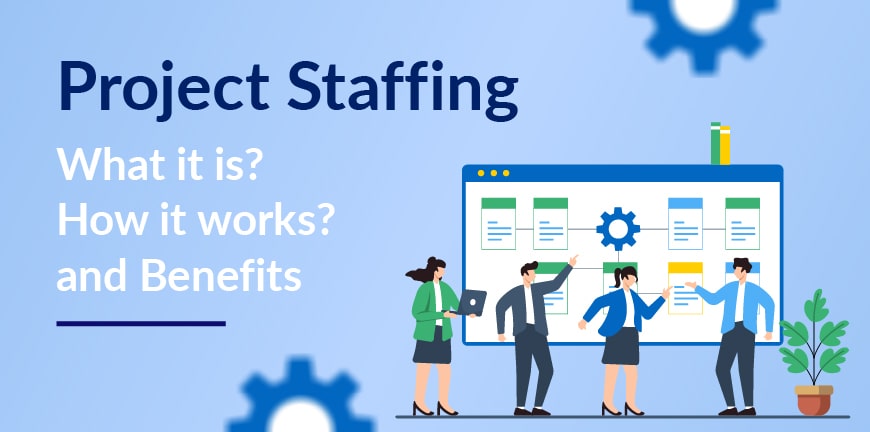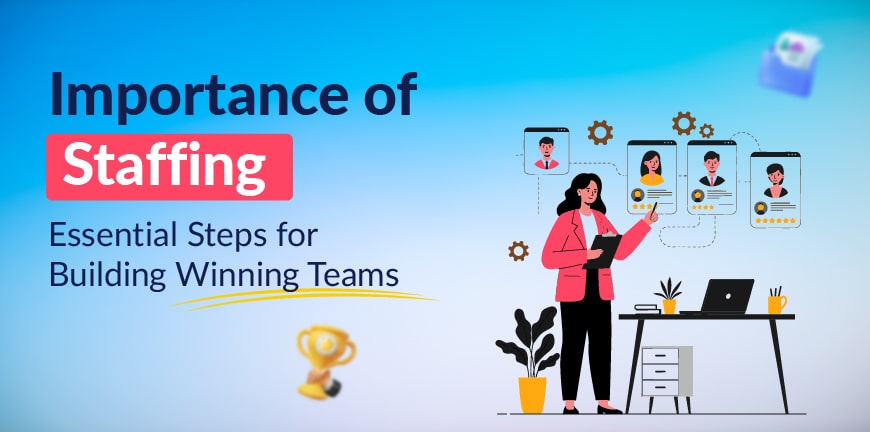
Difference Between JLPT N2 and N3 Candidates
12/07/2025
What is 360 Recruitment: A Detailed Guide for Employers
16/07/2025In a business landscape that is super dynamic, the definition of success is the culmination of how swiftly and efficiently a project is executed, keeping the quality intact. This is where project staffing surfaces.
Organizations are done with relying solely on permanent hires and are resorting to adjustable, on-demand staffing models that offer access to specialized expertise, diminished overhead expenses, and ensure agile functions.
It could be a new product launch or venturing into new markets or managing seasonal fluctuations. Project staffing is a link between you and skilled professionals who kick the ball rolling, keeping your timelines on point and your results on target.
What Is Project Staffing?
Project staffing, meaning, can be explained as the recognition, selection, and recruitment of professionals with specialized skills for specific projects. Businesses often work with external recruitment companies to recruit employees or gather a team of skilled individuals who work on specific projects with the necessary resources. This staffing model highlights roles and duties, ensuring teams and individuals can work proficiently within the set timeline.
How Does Project Staffing Work?
An organization primarily requires understanding the project, clearly defining the objectives, and the scope. They need to decipher the required roles, skills, and the period for every role, and accordingly design a robust plan.
The project staffing plan will include the specific number of individuals needed for each role and the specialized skills the client demands with the duration needed for them to perform the roles.
Businesses need to ascertain if the current teams of the organization can perform the required roles. If not, they need to look for options, like joining hands with staffing companies, hiring gig workers, or freelancers.
The next step is to hold interview sessions, analyse the skills and back stories of professionals who can work on various projects. After the assessment perfect candidates are selected for suitable project roles.
One of the integral parts of project staffing is merging new members into a team, providing necessary guidance and support, and ensuring they understand and accomplish the project stages and vision.
Organizations need to be cautious in handling and overseeing projects for smooth execution. There must be a clear design drawn in terms of distributing work and responsibilities to individuals.
It is essential to check the movements and performance of the teams and identify roadblocks by using appropriate tracking applications.
Companies ensure that there is transparent communication initiated by utilizing appropriate channels, making it easier for teams and clients to collaborate effectively.
Clear communication makes the identification of any problems or risks easy and can swiftly resolve them during the execution of projects.
As soon as a project ends, an organization quickly analyses the project and its results, understanding the outcomes and whether there is any room for improvement, also pointing out areas that need improvement.
The final call will be to ensure that all deliverables are met and the final closure of a project.
Why does Project-Based Staffing Matter?
Companies can benefit immensely from project-based hiring, as it allows them to alter the way they source independent contractors. Here are a few benefits that make project-based staffing matter:
1. Top skills and Expertise Access
Organizations can form a team of professionals with niche talent that caters to specific project requirements. Tapping into a wider talent bank and picking experts with skills exclusively required for optimum impact is the advantage companies have. The targeted professionals ensure that the projects are executed efficiently and on time.
2. Cost Effectiveness Accelerated
Project-based hiring allows organizations to pay only for expertise, eliminating the ongoing expenses that are related to training, office space, and additional benefits. This approach leads to cutting down on costs, as fixed salaries are not given to temporary workers, enabling companies to invest effectively in projects and allocate funds where it is most needed.
3. Smooth Sailing Scalability
Organizations can work hassle-free in evolving workforce scenes as they can adjust their staff according to the specific requirements of each project. During high-demand situations, additional help and workers can be brought in to meet the needs. The model ensures that businesses are not paying for excess resources, facilitating an organized and cost-efficient process.
4. Welcoming Fresh Outlook
A culture of innovation and creative ideas can be nurtured in organizations with experts from diverse backgrounds and industry expertise working on projects. They bring to the table new perspectives that might enhance growth by offering foolproof solutions and systems that can help you stay ahead in a competitive market.
5. Worldwide Talent Access
One of the most outstanding benefits of project-based recruitment is that businesses can source talent from any part of the globe, not worrying about geographical limitations. This is not possible with traditional hiring, as they are more reliant on talent close to the business. Project-based hiring enables a company to tap into a broad global network of skilled professionals and select individuals with niche skills.
What Are the Challenges of Project Staffing?
Just like project-based staffing is convenient and advantageous to companies, there are several challenges businesses might have to face. Let us look at some of the hurdles:
1. Recruiting Talent and Retention
In this competitive and ever-changing job landscape, organizations might find it hard to secure appropriate candidates for a particular project role. Sometimes, certain projects require prowess that might not be readily available, leading to delays and escalated costs.
It also becomes a challenge for companies to hold on to workers, as they might not feel valued enough to stay on for a project and seek a substantial increase in pay and better scopes.
2. Project Related Issues
There can be a budget restriction that can be a deterrent to recruiting a certain number of team members. It can also adversely affect the quality of talent required for the project.
A disorganized project scope can result in the disruption of resources, increasing costs, and hampering deadlines. Another challenge is a lack of proper communication, without appropriate channels, can lead to miscommunication and disengagement.
3. Technology and Market Developments
Project teams need constant training and guidance, with technological advancements making an entry in the market quite frequently. The project teams are required to keep up with adapting and receiving substantial training to meet the demands of the shifts occurring rapidly.
The job market today is also candidate-focused, and they have a plethora of opportunities and options, so appealing to the right candidates and retaining them can be an issue for organizations.
4. Ethics and Employee Welfare
Organizations must take a clear stance when it comes to laws and rules. These processes might be complicated and need to be adhered to properly. A significant challenge that companies face in the project staffing process is when they must integrate new employees with the existing team members.
There could be a clash of values, opinions, and culture. To attract and retain quality talent, employers must take care of employee health and their satisfaction at the workplace.
What Are the Key Trends of Project Staffing?
1. Remote and Hybrid Revolution
In recent years, the shift that stands out the most is the popularity of hybrid and remote work scenarios. Employers can now hire individuals remotely across the world.
2. Emphasizing Soft Skill Sets
Dynamic work landscapes and evolving business models have led organisations to adopt skills that matter the most, with technical expertise. These skills are known as soft skills, which include top-notch and transparent communication, the ability to solve issues, and emotional intelligence.
3. AI and Automation Incorporation
Recruitment models are largely integrating AI-powered tools and automation to expedite and smooth processes. From candidate selection to onboarding, these technologies enable organized procedures.
4. Gig Market Takes Centre Stage
Project-based hiring has spiked ever since the gig economy gained momentum, and more individuals seek temporary work or project-based assignments that are flexible as per demand. Niche-skilled workers are brought in to complete specific projects.
Are you looking for a Staffing Partner?
Are you searching for a staffing partner who understands your business requirements and objectives, and your project staffing model? Connect with us at Alp Consulting, a reputable and trusted staffing firm, building teams and providing robust staffing solutions since 1996.
Right partners like us can make all the difference., You could be requiring your talents for a short-term purpose or have a long-term requirement, or specialized skills; all you need is a staffing partner like us offering services that involve presenting not just resumes, but knowledge, speed, and talent that caters to your company’s culture and aspirations.
We not only diminish the recruitment duration but also enhance project outputs. We aim to enable you to stay ahead in the competitive arena and help create a team that meets your goals.
Frequently Asked Questions (FAQs)
1. What does project staffing mean?
Project staffing is a procedure that involves companies finding and recruiting individuals for specified projects with proper support and resources.
2. How is project staffing different from traditional hiring?
Traditional hiring focuses on permanent and long-term job roles, while project staffing is inclined towards hiring individuals for short-term and project-based roles.
3. What are the main benefits of project staffing?
Some of the critical benefits of project staffing entail flexibility, access to niche skills, cost-effective processes, and diminished risk.
4. What are the key steps in the project staffing process?
The several steps of a project staffing process include workforce planning, hiring, selection, training, and performance development.
5. What are the challenges in project staffing?
A few of the challenges that project staffing faces are workload management, controlling budget constraints, ensuring proper communication, etc.
6. How do you ensure the right fit in project staffing?
Ensuring the right fit in project staffing means that first, project requirements must be outlined clearly, an assessment of candidate skills and experience is significant, and then the evaluation of cultural alignment should be conducted.




